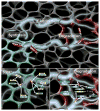Membrane-associated matrix proteolysis and heart failure
- PMID: 23287455
- PMCID: PMC4026203
- DOI: 10.1161/CIRCRESAHA.112.266882
Membrane-associated matrix proteolysis and heart failure
Abstract
The extracellular matrix (ECM) is a complex entity containing a large portfolio of structural proteins, signaling molecules, and proteases. Changes in the overall integrity and activational state of these ECM constituents can contribute to tissue structure and function, which is certainly true of the myocardium. Changes in the expression patterns and activational states of a family of ECM proteolytic enzymes, the matrix metalloproteinases (MMPs), have been identified in all forms of left ventricle remodeling and can be a contributory factor in the progression to heart failure. However, new clinical and basic research has identified some surprising and unpredicted changes in MMP profiles in left ventricle remodeling processes, such as with pressure or volume overload, as well as with myocardial infarction. From these studies, it has become recognized that proteolytic processing of signaling molecules by certain MMP types, particularly the transmembrane MMPs, actually may facilitate ECM accumulation and modulate fibroblast transdifferentiation; both are critical events in adverse left ventricle remodeling. Based on the ever-increasing substrates and diversity of biological actions of MMPs, it is likely that continued research about the relationship of left ventricle remodeling in this family of proteases will yield new insights into the ECM remodeling process and new therapeutic targets.
Figures



References
-
- Konstam MA, Kramer DG, Patel AR, Maron MS, Udelson JE. Left ventricular remodeling in heart failure: current concepts in clinical significance and assessment. JACC Cardiovasc Imaging. 2011 Jan;4(1):98–108. - PubMed
-
- Quiñones MA, Greenberg BH, Kopelen HA, Koilpillai C, Limacher MC, Shindler DM, Shelton BJ, Weiner DH. Echocardiographic predictors of clinical outcome in patients with left ventricular dysfunction enrolled in the SOLVD registry and trials: significance of left ventricular hypertrophy. Studies of Left Ventricular Dysfunction. J Am Coll Cardiol. 2000 Apr;35(5):1237–44. - PubMed
-
- White HD, Norris RM, Brown MA, Brandt PW, Whitlock RM, Wild CJ. Left ventricular end-systolic volume as the major determinant of survival after recovery from myocardial infarction. Circulation. 1987 Jul;76(1):44–51. - PubMed
-
- Weir RA, McMurray JJ, Velazquez EJ. Epidemiology of heart failure and left ventricular systolic dysfunction after acute myocardial infarction: prevalence, clinical characteristics, and prognostic importance. Am J Cardiol. 2006 May 22;97(10A):13F–25F. Epub 2006 Apr 21. - PubMed
-
- Sutton MG, Sharpe N. Left ventricular remodeling after myocardial infarction: pathophysiology and therapy. Circulation. 2000 Jun 27;101(25):2981–8. - PubMed
Publication types
MeSH terms
Substances
Grants and funding
LinkOut - more resources
Full Text Sources
Other Literature Sources
Medical

